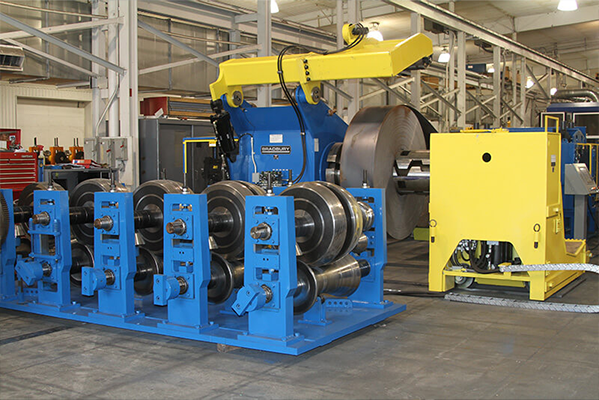Navigation Menu
Contact Us
- Email:
- info@wxavatar.com
- Address:
- Yurong Village, Yuqi Street, Huishan District, Wuxi, China.
Release Date:Mar 31, 2025 Visit:54 Source:Roll Forming Machine Factory
Thick heavy gauge roll forming lines are pivotal in modern manufacturing, enabling the production of high-strength metal profiles for industries such as construction, energy, transportation, and automotive. These systems excel in shaping thick metal sheets (typically 3–20 mm or more) into precise, durable components. Below, we explore their key advantages, supported by technological innovations and industrial applications.
1. High Precision and Consistency in Wall Thickness Control
Heavy gauge roll forming lines utilize advanced roller dies and computer-controlled systems to achieve precise wall thickness tolerances (±0.5 mm or better). By optimizing parameters such as roll pressure, speed, and tool geometry, these systems ensure uniform deformation of thick materials like high-tensile steel and aluminum alloys. For example, real-time monitoring with IoT-enabled sensors and PLC systems allows adjustments during production, minimizing deviations and enhancing product quality. This precision is critical for load-bearing components in infrastructure and machinery, where even minor inconsistencies could compromise structural integrity.
2. Material Efficiency and Cost Savings
Roll forming minimizes material waste through continuous processing. Unlike stamping or forging, which generate significant scrap, roll forming incrementally shapes metal coils into profiles, reducing raw material consumption by up to 30%. Additionally, the cold-forming process preserves material properties, avoiding the energy costs and metallurgical changes associated with heat-based methods like extrusion. This efficiency is particularly advantageous for high-cost alloys used in aerospace and renewable energy applications.

3. High Production Speed and Flexibility
Automated heavy gauge lines operate at high speeds, producing long, continuous profiles without interruption. Integrated systems, such as servo-driven uncoilers and flying cutoff saws, streamline workflows, enabling rapid transitions between different profiles by swapping roller dies. For instance, VLB Group’s RF series lines support sheet widths up to 1,400 mm and thicknesses from 0.3–12 mm, adapting to diverse industrial requirements. This flexibility allows manufacturers to cater to both mass production and custom small-batch orders, such as seismic-resistant steel frames or wind turbine components.
4. Enhanced Strength and Durability
The cold-forming process strengthens metal grains through work hardening, resulting in components with superior mechanical properties. Heavy gauge lines are ideal for producing structural elements like beams, channels, and pipelines, which require high fatigue resistance and load capacity. For example, thick-walled steel tubes for oil and gas pipelines withstand extreme pressures and corrosive environments, demonstrating the durability of roll-formed products.
5. Integration with Advanced Technologies
Modern heavy gauge lines incorporate automation, AI, and IoT to boost productivity. CNC-controlled systems ensure precise alignment and repeatability, while predictive maintenance tools reduce downtime by monitoring equipment health in real time. Hybrid lines combining roll forming with laser cutting or robotic welding further expand capabilities, enabling all-in-one processing of complex geometries. These innovations align with trends toward smart manufacturing, where data-driven optimization enhances energy efficiency and reduces operational costs.
6. Sustainability and Environmental Benefits
Roll forming’s low energy consumption and minimal waste generation align with global sustainability goals. Cold-forming eliminates emissions from heating processes, and scrap metal from trimming can be recycled. Companies like Minth Group and Aisin Seiki are adopting eco-friendly practices, such as using recycled alloys and optimizing production layouts to reduce carbon footprints.

Challenges and Future Outlook
While heavy gauge roll forming offers significant benefits, challenges include high initial investment and the complexity of handling ultra-thick materials (>25 mm)512. Future advancements are expected to focus on:
Lightweight Materials: Incorporating advanced alloys for electric vehicles and aerospace.
Digital Twins: Simulating processes to optimize tooling and reduce trial runs.
Circular Economy: Enhancing scrap recycling and energy recovery systems.
Conclusion
Thick heavy gauge roll forming lines are indispensable for manufacturing robust, high-precision metal components. Their advantages—precision, efficiency, flexibility, and sustainability—position them as a cornerstone of industries demanding strength and reliability. As technology evolves, integration with AI and green manufacturing practices will further solidify their role in shaping the future of industrial production.